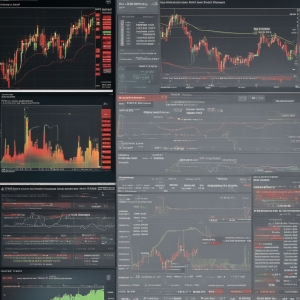Table of Contents:
Understanding the basics of cryptocurrency trading is quite essential, but the real test begins when you dive into advanced trading strategies. These strategies, although sophisticated, can open a plethora of opportunities and provide a competitive edge in the volatile crypto market. They are designed for seasoned traders who want to enhance their trading proficiency. In this article, we will give you comprehensive insights into advanced trading strategies to help you stand out from the crowd.
Introduction to Advanced Trading Strategies
Advanced trading strategies comprise of some complex techniques and practices, providing a critical edge in the crypto market. These strategies are not just about buying when the price is low and selling when it's high; they involve many multi-faceted approaches including market analysis, appropriate risk management, and responsive decision making. They can be highly beneficial and lucrative, but also pose certain risks – especially if not thoroughly understood and implemented. So, it's vital to understand these strategies, their dynamics, and implications before using them in real trade scenarios.
Moving from Basics to Advanced Techniques
For any trader familiar with the basics, the next step entails embracing more advanced methodologies for improved trading outcomes. These advanced trading techniques are more than just setting buy and sell orders. They incorporate various aspects such as technical analysis, algorithmic trading, and even sentiment analysis. They act as a catalyst, preparing traders for intensive market activity, guiding them through the nuances of hard core trading, and helping them understand the intricacies of the crypto market. Let's delve into some of these advanced strategies.
Advanced Trading Strategies: Pros and Cons
| Strategies | Pros | Cons |
|---|---|---|
| Long Term Investing | Potentially high return on investment in the long run, lower risk of loss compared to short term investment | Requires patience, could take several years to see significant returns |
| Short Term Trading | Potential for quick profits, offers more opportunities due to high liquidity | Higher risk, requires more time, skills and knowledge |
| Day Trading | Can yield profits in a short time, potential for high returns if done correctly | Very high risk, stressful, requires constant monitoring |
| Swing Trading | Fewer transactions mean lower costs, reduces the risk of being affected by short-term market ups and downs | Daily monitoring of stocks is still necessary, profit might take longer than day trading |
Understanding and Applying Technical Analysis

One of the key advanced trading strategies worth understanding is technical analysis. This involves looking at past market data, particularly the price and volume, to identify potential trading opportunities. It encompasses various analytical techniques such as candlestick patterns, trend lines, and moving averages that help in predicting future price movements.
Applying technical analysis can be a game-changer for seasoned traders. It empowers them with the ability to understand the market trends and make informed trading decisions. Charts, patterns, and indicators become their guide, helping them decipher the market nuances that otherwise remain unnoticed. It's a powerful strategy, but it requires practice and precision to master it.
Mastering technical analysis not only helps you understand the ongoing market trends and patterns but also assists in predicting future price actions. Despite the predictive power and advanced insights it provides, traders must remember that like any strategy, it's not foolproof. Therefore, it's crucial to combine it with adequate risk management tactics and maintain a diversified portfolio to mitigate potential losses.
Mastering the Art of Risk Management
Risk management is another integral advanced trading strategy. Successful trading isn't simply about maximizing profits but also about minimizing potential losses. This is where effective risk management comes into play. It involves setting up safety measures against unforeseen market downturns and adverse price movements.
One of the key risk management techniques for seasoned traders is setting stop losses. This strategy allows traders to limit their losses if the market doesn't perform as expected. Another crucial strategy is diversification. By spreading your investments across multiple cryptocurrencies, you can mitigate the risk associated with any single cryptocurrency’s performance.
Risk management can sometimes require you to stand against your instincts. It might require you to sell off a seemingly profitable asset to avoid potential losses. It becomes relevant especially in times of extreme volatility where drastic price movements can occur within short periods, which is a characteristic trait of the cryptocurrency market.
Prudent risk management can significantly impact your trading results. But remember, there's no one-size-fits-all strategy. Each trader might need a customized risk management strategy catering to their trading style, risk tolerance, and the market conditions. Thus, alongside mastering advanced trading strategies, having a grip on robust risk management techniques is equally critical.
Leveraging on Options and Futures

Options and Futures are hightly influential advanced trading strategies. They can offer seasoned traders a new dimension to trading, hedging potential risks and capitalising on market volatility.
Options trading offers the right, not the obligation, to buy or sell a certain asset at a predetermined price within a certain timeframe. It provides traders the flexibility of speculating on the price directions without owning the actual assets.
In contrast, futures contracts obligate the traders to buy or sell an asset at a predetermined price and date in the future. Futures can help traders hedge against potential price volatility and speculate on future price movements without owning the underlying asset.
Both options and futures can be complex and involve significant risk. Therefore, it's important for traders to fully understand how these contracts work, including their potential rewards and risks, before trading in them.
Seasoned traders often leverage these strategies to navigate through volatile market scenarios or hedge their open positions, thus enhancing their trading arsenal. Yet, these strategies should be used judiciously and with thorough understanding, given the high risk associated with them.
Regardless of the strategy chosen, it is critical that traders continually educate themselves and stay up to date with market dynamics to make informed trading decisions.
Exploring Forex Trading Strategies
The Foreign Exchange Market, more commonly known as Forex, is an exciting realm for advanced traders. Forex trading strategies are various in nature and based on diverse sets of principles and tactics. Implementing these strategies effectively could potentially open doors to lucrative gains.
One of the commonly applied strategies in Forex trading is the use of leverage. It allows traders to control larger amounts with comparatively small capital. However, while this can amplify profits, it could also lead to enormous losses. Therefore, understanding and carefully utilizing leverage is crucial for managing potential risks.
The 'carry trade' is another advanced Forex trading strategy. This entails borrowing a currency with a low-interest rate and using it to purchase another currency yielding high interest. The difference between rates could be a profitable venture, provided the currency values remain stable during the trade.
Forex markets also offer scope for algorithmic trading, where trades are executed by computer programs driven by a defined set of instructions. This strategy allows for high-speed trading and reduces the risk of human errors.
The 'scalping' strategy aims to profit from minute changes in the currency value. It's a short-term strategy, demanding frequent market monitoring and quick decision-making capabilities. These strategies, among many others, enable seasoned traders to harness the dynamic nature of the Forex market. However, like every advanced strategy, they require thorough knowledge, careful execution, and prudent risk management.
Harnessing the Power of Algo-Trading

Algorithmic trading, also known as algo-trading, has reshaped the landscape of cryptocurrency trading in recent years. This advanced strategy involves using computer algorithms to execute a variety of trade orders at incredibly high speeds. It allows seasoned traders to set specific rules for both trade entries and exits that can be automatically executed when certain conditions are met.
Algo-trading adds a new dimension to trading as it reduces the chances of human error and eliminates the need for constant monitoring. The algorithms used in this approach can analyze market conditions across multiple cryptocurrency exchanges and execute trades based on predefined instructions. From determining the optimal order size to identifying the best time to make a trade, algo-trading can do it all.
Although implementing algo-trading can be technically challenging, various tools and platforms have emerged, making it accessible to traders with limited programming skills. However, one should bear in mind that while algo-trading can increase trading speed and precision, its efficiency largely depends on the reliability and complexity of the underlying algorithms. Hence, a thorough understanding of the programming language and trading algorithms is essential to harness the full potential of this advanced strategy.
Ultimately, algo-trading is a double-edged sword. It can significantly boost trading efficiency and accuracy, but if not monitored and controlled effectively, it can also lead to substantial losses. Therefore, while using algo-trading to enhance trading outcomes, traders should concurrently establish robust risk management procedures and regularly review their algorithms performance.
Making Use of Arbitrage in Cryptocurrency
Another unique trading strategy, often considered advanced due to its specificity, is arbitrage. In the realm of cryptocurrencies, arbitrage involves profiting from the price differences of the same cryptocurrency on different exchanges. In simple terms, you buy a cryptocurrency from one exchange where its price is low and sell it on another exchange where the price is higher.
Arbitrage is deemed advanced due to several reasons. One, it requires a comprehensive understanding of the market since tracking price variations and making quick decisions is imperative. Two, it often requires sizeable capital since the percentage differences in prices can be quite small, and larger volumes are required to reap significant profits. Lastly, there's the technical challenge of executing trades almost simultaneously on different exchanges to maximize profits and avoid potential losses.
Despite the complexities, arbitrage can be a quite profitable strategy if implemented correctly. It is also said to contribute to market stability since arbitrage traders "even out" price discrepancies across different platforms. But like any other trading strategy, it is crucial to thoroughly study and understand the dynamics of arbitrage before adopting it in your trading repertoire.
Incorporating Signal Following in Your Strategy
Signal following is another notable advanced trading strategy that can significantly enhance your trading performance. It involves tracking and analysing the actions of experienced and successful traders and replicating their trades in real-time. This process is automated through advanced software tools, commonly referred to as trade signal systems.
This strategy provides you with an opportunity to leverage the expertise of seasoned traders, even if you lack the same level of knowledge or experience. It can be very effective, particularly for traders who are still mastering the myriad of advanced trading techniques and strategies.
However, while this strategy can provide immediate and accessible trading directions, it's not without risks. The prospect of great returns can diminish your due diligence, potentially leading to losses. Therefore, it's crucial not to solely rely on signal following.
Combining it with other techniques can provide a balanced strategy. For instance, implementing sound risk management practices alongside signal following can help ensure profitability, even when some trades do not pan out as hoped. Therefore, while signal following can be a strong addition to your trading strategy, it must be used wisely and in conjunction with other advanced techniques.
Conclusion: The Road Towards Successful Trading
In the end, the efficacy of these advanced trading strategies hinges on your understanding, implementation, and consistent modification based on unfolding market dynamics. From technical analysis to risk management and leveraging futures and options, these strategies call for profound knowledge of the crypto market. They require a firm grasp on fine-tuning your actions and strategies according to the evolving market conditions.
An important point to remember is that even after mastering these advanced strategies, you might face certain challenges. The crypto market is volatile and at times unpredictable. Failure is a part of the process. What matters is how quickly and effectively you learn from these failures and how you incorporate these lessons into your future transactions.
Become equipped with these strategies, but also stay agile and ready to adapt to new techniques and market changes. The road towards successful trading isn't determined by the number of times you win, but by how you play the game.
FAQ on Advanced Trading Strategies
What are some advanced strategies for seasoned traders?
Some advanced strategies include pair trading, market-neutral strategy, and event-driven strategy. Seasoned traders can leverage these strategies to minimize risk and enhance capital preservation.
How can one effectively implement pair trading?
Effectively implementing pair trading involves identifying two assets that move in correlation. Traders then take a simultaneous long position in one security and a short position in another.
What is a market-neutral strategy?
A market-neutral strategy involves taking a long and short position in two different securities. The aim is to achieve a balance, with positive investment returns regardless of the direction of the overall market.
How does an event-driven strategy work?
An event-driven strategy is a type of investment strategy that attempts to take advantage of temporary stock mispricing that may occur before or after a corporate event takes place.
For a seasoned trader, which strategy works best?
The choice of strategy depends on the trader's experience, risk tolerance, and market conditions. All strategies carry potential risks and reward opportunities that should be evaluated and understood.












